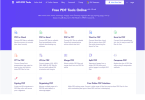Smart teachers are already using AI to save time and help students learn better. But to become a better teacher with AI, you need to know which tools work best for specific teaching tasks and how to use them effectively with the methods you already use. So let’s break it down.
Contents
Why Teachers Need AI Now
Everyone working in education wonders how to become a better teacher. This is especially difficult today. In 2025, class sizes are larger, there are different learning needs, and teachers have too much administrative work, and they feel pressured to personalize their teaching for every student.
AI tools can help with these challenges because they cah:
- Automate routine for the teacher
- Give thousands of students instant feedback in seconds
- Smartly customize learning plans for everyone in the class
To improve as a teacher, you need to use AI, but you also need to keep the personal connection with your students, which can’t be replaced. Educators exploring practical AI tools to enhance their workflow may find value in platforms like Ohai.ai, which offer organizational support for daily planning and task management. Integrating such tools can help streamline lesson preparation and administrative responsibilities, allowing teachers to focus more on student engagement.
Understand How AI Works in Education
Before exploring specific tools, let’s talk about how AI can and can’t be used in the classroom. AI is very good at:
- Handling a lot of data quickly
- Finding ways to understand how students are doing in their classes
- Making different versions of content for different learning levels
- Giving feedback on assessments instantly
- Doing all sorts of office tasks, so you don’t have to
But AI can’t replace your judgment or intelligence. It also won’t help you motivate students. This means that you can’t replace yourself with a robot. You still have to be present, but you can get an assistant to free up time to improve the system in ways you have only dreamed about but lacked the resources to implement.
Best AI Tools for Teachers
Now that we’ve covered that, here are three tools you can use in your classroom to become a better teacher:
1. Overchat A
Ask Overchat AI to find any content that may have been created by AI in student submissions. This is very important for making sure that homework was actually done by students in a time of AI writing assistants.
Here’s how to use Overchat AI:
- Open Overchat AI Detector
- Upload a text submitted by a student
- Click analyze
The AI Detector looks at how people write, the structure of sentences, and the words they use and gives you a score from 0% to 100%. 0% means the text is definitely written by a person, and 100% means it’s definitely AI generated. Use the results to start talking with students about their work.
Here’s something to keep in mind: often, the detector will fall somewhere in the middle, between 65% and 75%. This can happen if the text was generated by a computer but heavily edited by a person. If that’s the case, it’s up to you to decide if that kind of AI use is okay.
2. Perplexity AI
Perplexity is an AI-powered search engine. It works like ChatGPT, but for every answer it provides, it quotes sources. It’s very useful when you need to:
- Find current statistics and studies for lectures quickly
- Make sure the information is correct before sharing it with your students
- Learn about different points of view on topics that people have different opinions about
But you can also use Perpexity in the classroom. Here’s how::
- Teach students to evaluate sources by looking at citations that Perplexity AI provides
- Use it in class to answer student questions that you didn’t expect
- Have students compare the results of Perplexity with traditional research methods
3. ChatGPT
ChatGPT can help you plan lessons more quickly and improve their quality, too.
When planning lessons, give ChatGPT specific instructions. Instead of asking, tp Create a science lesson, try this prompt: Create a 50-minute lesson plan for teaching photosynthesis to 9th graders, including a hands-on activity.
You can also use ChatGPT to create different versions of the same lesson.
After you get the first version, ask it to modify the lesson for advanced students or simplify it for students who need extra help. This way, you can quickly make materials for different learning levels without starting from scratch.
Watch Out for These Mistakes
Many teachers make similar mistakes when they start using AI. Here are the two most common ones:
- The main problem is relying too much on AI without checking the quality of what it produces. AI can sometimes generate incorrect information, so check the facts.
- Another mistake is not customizing AI content. Your students can tell when something doesn’t sound like you. Take the time to edit AI-generated content.
Bottom Line
Start using these tools now. Try Overchat AI to help you plan your next lesson, and explore Perplexity AI for quick research. Share what works with other teachers and learn from their experiences, too. But if you’re still wondering how to become a better teacher, remember that using AI is just one way to do so, and it’s definitely worth giving it a try.







